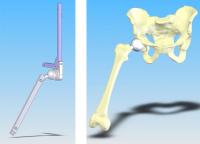|
From rxpgnews.com Hip
To be completely successful, CAOS hip replacement surgery must take into account tiny human skeletal differences. Imprecise measurements, which could result from conditions seemingly unrelated to the surgery, such as operation room noise or temperature, can lead to poor positioning of implants, leaving some former patients with discomfort during walking and, in rarer cases, a need to redo the operation. The researchers have built a lightweight device called a âphantomâ that resembles the artificial socket, ball and femur substitutes that surgeons use to replace the joint and bone in hip operations, based on a calibrated XY coordinate frame. They drilled tiny holes at precisely measured intervals into the phantom and made cuts at precisely measured angles, favored by surgeons for CAOS operations. Because the precise coordinates of the mechanical (magnetic) ball and socket joint center of rotation have been measured, manufacturers of CAOS tracking sensors can use the phantom to test the accuracy of their measuring instruments. Surgeons also should be able to test the accuracy of their CAOS devices, just before making their first incision, to measure ball and socket joint center of rotation coordinates, angles for cuts into the bone and places for the insertion of screws Currently, no standardized approach to the evaluation of CAOS technology exists, but an ASTM International committee is working on the establishment of such standards. In the coming months NIST will submit its hip CAOS phantom to orthopaedic surgeons for review. Clinical trials could follow. If the device wins Federal Drug Administration (FDA) approval, it can be expected to find its way into operating rooms across the country and world. The researchers look forward to extending the application of the technology to surgical procedures on the knee and shoulder. All rights reserved by RxPG Medical Solutions Private Limited ( www.rxpgnews.com ) |
